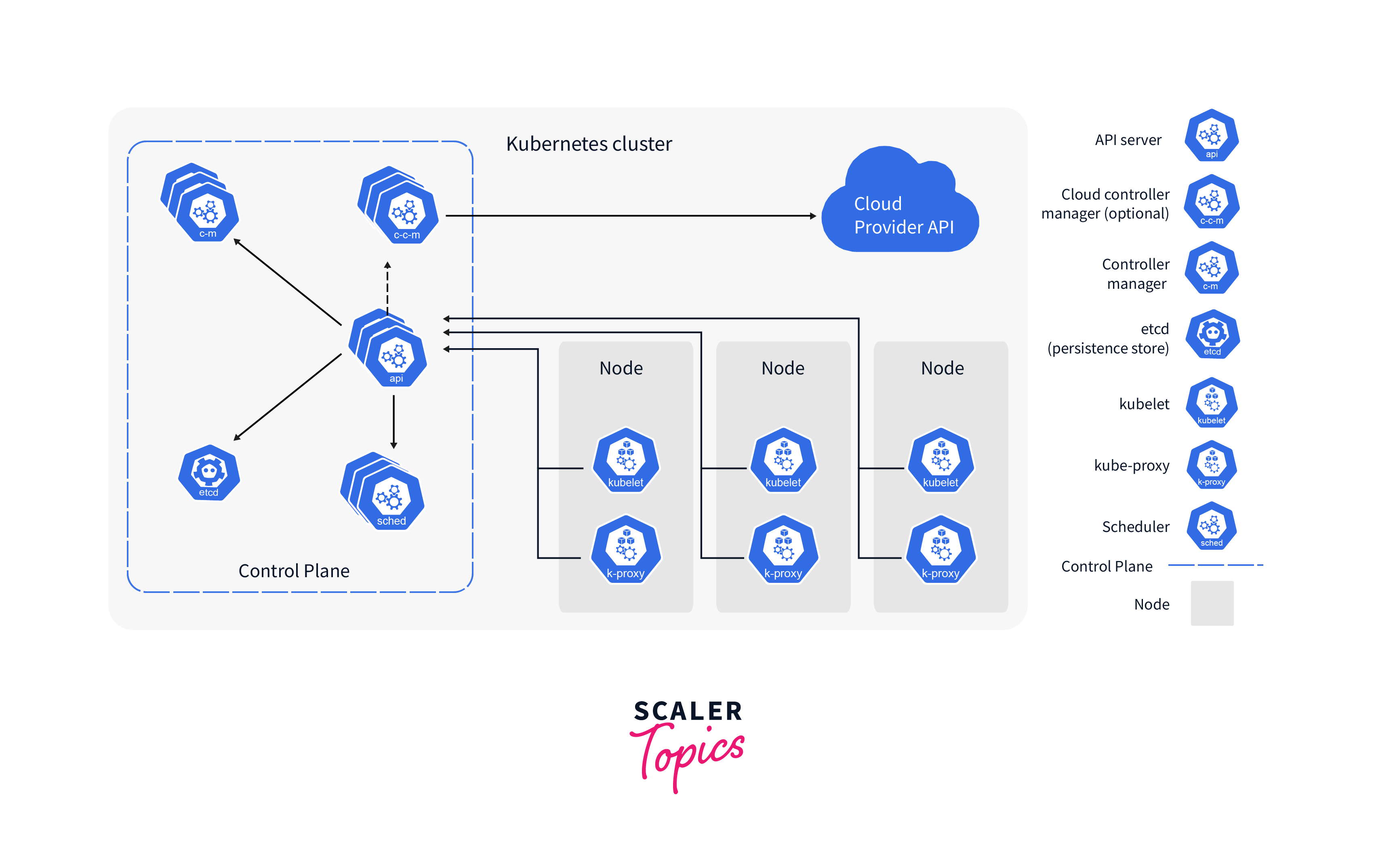Kubernetes Control Plane
Overview
In the world of container orchestration, Kubernetes has emerged as a leading platform, empowering businesses to deploy, manage, and scale applications with ease. At the heart of Kubernetes lies the Control Plane – a crucial ensemble of components responsible for overseeing the entire cluster's operations.

Join us on this journey to discover the inner workings of the Kubernetes Control Plane and unlock the potential for seamless application deployment and management.
What is Kubernetes Control Plane?
The Kubernetes Control Plane serves as the backbone of a Kubernetes cluster, responsible for managing its resources, including worker nodes and pods. It operates by constantly receiving and processing information related to cluster activities and incoming requests, using this data to transition the cluster resources from their current state to the desired state. This approach ensures fault tolerance and high availability of applications in the cluster.
Control Plane as a Part of Kubernetes Architecture
As a vital part of the Kubernetes architecture, the Control Plane communicates instructions to the worker nodes, guiding them in executing tasks and performing various functions. The worker nodes consist of three primary components: kubelet, kube-proxy, and container runtime. Together, these components handle incoming requests forwarded by the Control Plane.
The kubelet acts as an agent that facilitates the interaction between the Control Plane and the worker nodes. On the other hand, kube-proxy applies the Service Concept, ensuring that pods adhere to network rules and efficiently routing traffic based on these rules. Lastly, the container runtime executes and manages containers. Additionally, the Control Plane engages with other add-ons to accomplish specific tasks and address particular requests within the Kubernetes cluster.
Components of Kubernetes Control Plane
The Kubernetes Control Plane is a critical set of components that act as the "brain" of the cluster, overseeing and managing its overall operations. These components work collaboratively to maintain the desired state of the system and ensure that applications run seamlessly.

Kube-apiserver
Serving as the gateway to the Kubernetes API, kube-apiserver plays a pivotal role in managing the container lifecycle and handling end-to-end operations. By serving client requests for Kubernetes resources, it enables the cluster to scale horizontally, maintain high availability, and optimize resource utilization.
As traffic and resource demands fluctuate, kube-apiserver dynamically creates multiple instances, allowing the cluster to efficiently handle requests and deliver top-notch performance.
Kube-scheduler
The kube-scheduler is responsible for intelligent pod scheduling, ensuring that pods are assigned to suitable nodes based on a variety of constraints. These constraints may include the time sensitivity of a request, specific policies, data locality, hardware capabilities, software requirements, and more. By making informed decisions about pod placement, the kube-scheduler optimizes resource allocation and enhances the overall performance of the cluster.
Kube-controller-manager
As the backbone of the control plane, the kube-controller-manager comprises a set of controllers, each monitoring and managing different Kubernetes resources. These controllers continuously work to enforce the desired state specified in the resource's specification. For instance, the Node Controller tracks node statuses, onboards new nodes and ensures pods are assigned to healthy nodes.
The Job Controller orchestrates one-time tasks by creating and sending them to newly spawned pods for completion. The EndpointSlice Controller manages network endpoints belonging to the same service, while the ServiceAccount Controller handles the creation and reconciliation of default ServiceAccounts in new namespaces. Combining all controllers into one binary process streamlines operational complexity and enhances the overall performance of the control plane.
Cloud-controller-manager
In cloud-based Kubernetes deployments, the cloud-controller-manager takes center stage, interacting with cloud-specific APIs and resources. This component abstracts differences between various cloud providers, offering a standardized interface for managing cloud-specific resources within the Kubernetes cluster.
Similar to the kube-controller-manager, the cloud-controller-manager also manages different types of controllers, including the Node Controller, Route Controller, and Service Controller. It ensures that nodes in the cloud respond effectively and remove inactive nodes if necessary, handles the creation and management of routes within the cloud infrastructure, and oversees the creation and management of service resources in the cluster.
etcd
Serving as the distributed key-value store, etcd is the heart of the Kubernetes control plane, containing crucial information about the current and desired states of the system. All cluster data is stored in etcd, serving as the single source of truth that the api server uses to bridge the gap between the desired and actual states of the cluster. The stability and reliability of etcd are crucial to the overall health and performance of the Kubernetes cluster.
These five components, working in harmony, form the Kubernetes Control Plane, orchestrating the various components and resources in the cluster to ensure the smooth execution of applications and the overall stability of the system. The proper functioning and optimal configuration of the control plane are fundamental to harnessing the full potential of Kubernetes and reaping its benefits for modern application deployment and management.
Why should we Use Kubernetes Control Plane?
The Kubernetes Control Plane serves as the powerhouse of a cluster, ensuring components operate in the desired state. Key benefits include:
- Desired State Management:
Maintains worker nodes and cluster components in the desired state, promoting stability and efficiency. - Efficient API:
Facilitates seamless communication within the cluster and with external services. - Optimized Resource Sharing:
Intelligently allocates resources and schedules pods for high-performance execution. - Resilience and Adaptability:
Monitors and enforces the desired state of Kubernetes resources. - Persistent Data Store:
Stores crucial configurations, providing a single source of truth. - Cloud Resource Management:
Abstracts cloud provider differences, ensuring consistency across environments.
By harnessing these capabilities, organizations achieve efficient cluster management and automated orchestration for enhanced application performance.
Control Plane Responsibilities
The Kubernetes Control Plane assumes a vital role within the cluster, overseeing and managing all its components. It governs cluster operations, configures and maintains the cluster's configuration and state data, and ensures the seamless deployment and management of containerized applications. All core components, which interact with worker nodes, form integral parts of the Control Plane.
One of the key components in the Control Plane is the Kubernetes API server. Acting as the sole interface to manage pod configuration information stored in etcd, the API server handles all Kubernetes commands and instructions. Setting up the Control Plane is the initial step in creating a cluster, and its absence renders the worker nodes incapable of starting or functioning. Without the Control Plane, a Kubernetes cluster cannot operate.
To work with the Control Plane effectively, understanding how to interact with the REST endpoints exposed by the Kubernetes API server through the kube-apiserver command is crucial. Learning about Control Plane communication is well-documented in the official Kubernetes documentation, while tools like the kubectl command facilitate interaction with the API server.
Furthermore, the Control Plane node diligently monitors the health of containerized applications and, where applicable, collaborates with the cloud provider to ensure the smooth execution of containerized applications. This proactive approach ensures the cluster operates optimally and delivers high-performance application management.
Best Practices
To ensure the efficient and secure operation of the Kubernetes Control Plane, consider implementing the following best practices:
- High Availability and Fault Tolerance:
Create multiple replicas of the control nodes and distribute them across different availability zones to achieve high availability. This approach enhances the system's fault tolerance and resilience, enabling it to handle surges in traffic effectively. - Automated Monitoring:
Automate the monitoring process of the Control Plane to streamline troubleshooting, workload management, and resource allocation. By doing so, you can enhance the cluster's operational efficiency and improve the productivity of operations personnel. - Role-Based Access Control (RBAC):
Implement RBAC policies to enforce usage restrictions and enhance the overall security of the Kubernetes cluster. This practice ensures that only authorized users have access to critical resources and operations.
In addition to the above best practices, consider the following strategies to optimize your cluster architecture and security:
- Stay Updated:
Always use the latest version of Kubernetes to benefit from the latest features, bug fixes, and security enhancements. - Auto-Scaling:
Leverage auto-scaling capabilities to keep the cluster operating at optimal efficiency. Auto-scaling allows the cluster to adapt dynamically to varying workloads, ensuring resources are utilized efficiently. - Training and Workshops:
Conduct workshops on control plane functionality and management tools to empower the team with the necessary skills and knowledge for effective control plane management. - GitOps Workflow:
Consider adopting a GitOps workflow, where Kubernetes configurations are declaratively managed through version-controlled repositories. This approach promotes transparency, traceability, and consistency in cluster configurations.
FAQs
Q. What is the role of the Kubernetes Control Plane in a cluster?
A. The Kubernetes Control Plane acts as the brain of the cluster, managing and maintaining the desired state of the system. It oversees critical tasks such as scheduling pods, scaling applications, and ensuring high availability and fault tolerance.
Q. How does the Kubernetes Control Plane handle component failures?
A. Kubernetes Control Plane components are designed with self-healing capabilities. If any component fails, Kubernetes automatically attempts to restart it. In highly available configurations, redundant instances take over, ensuring continuous cluster operation.
Q. Can I run the Kubernetes Control Plane on a separate set of nodes from my applications?
A. Yes, it is recommended to run the Control Plane on dedicated nodes separate from application nodes. This practice ensures resource isolation and enhances security, allowing the Control Plane to manage and monitor the cluster efficiently.
Conclusion
- The Kubernetes Control Plane efficiently manages the cluster's state and resources, ensuring seamless operations and scalability.
- Its core components, such as kube-apiserver and kube-scheduler, enable automated orchestration and efficient allocation of resources, guaranteeing high availability for applications.
- Adhering to best practices, including RBAC implementation and automated monitoring, enhances cluster performance and strengthens security measures.
- Understanding the Control Plane's responsibilities empowers users to efficiently manage applications and resources within the cluster.
- Leveraging the Control Plane's capabilities results in smooth application deployment and optimized resource utilization, promoting a streamlined operational workflow.
- As a vital component of Kubernetes environments, the Control Plane plays a pivotal role in achieving optimal cluster performance, making it indispensable for modern containerized applications.
